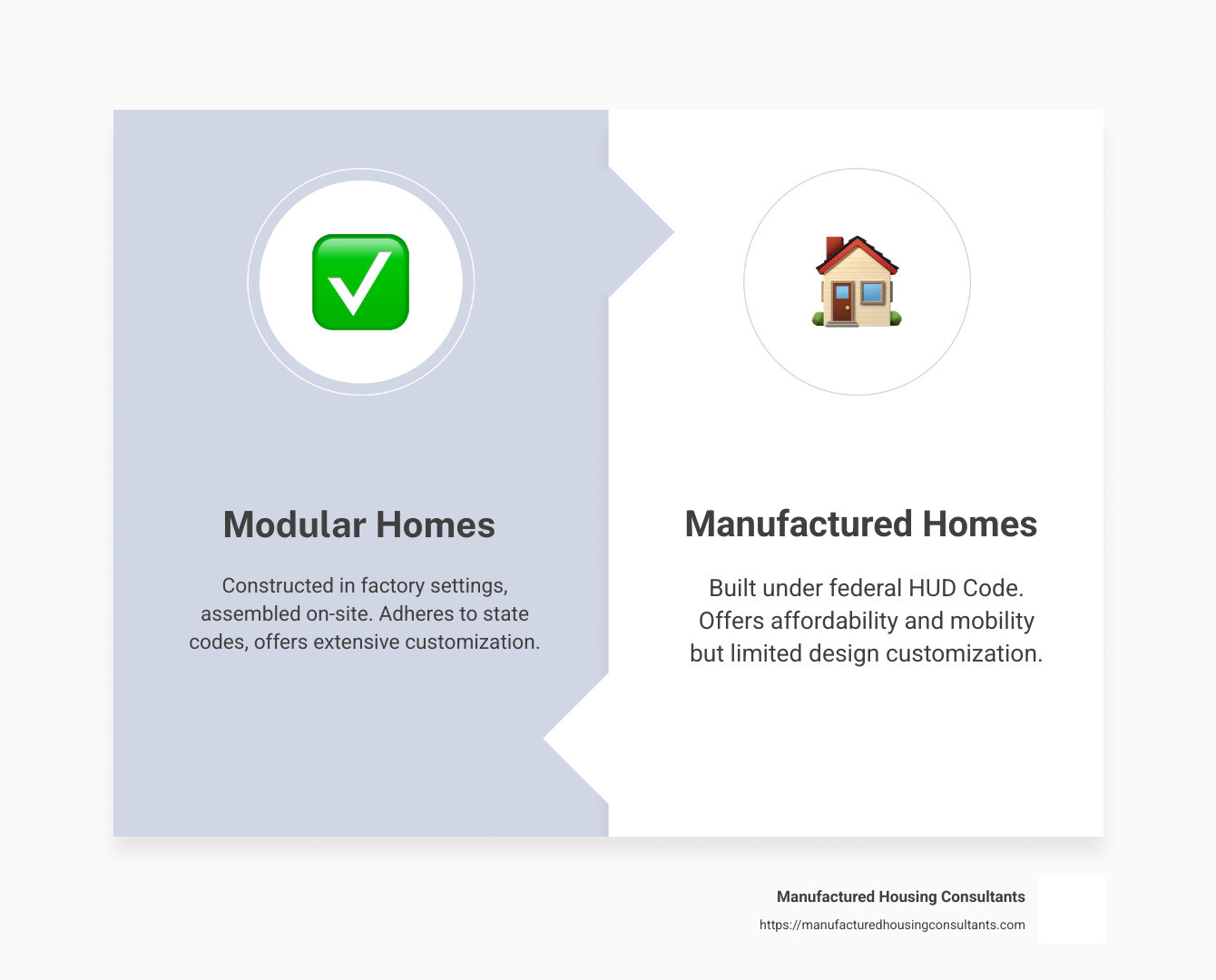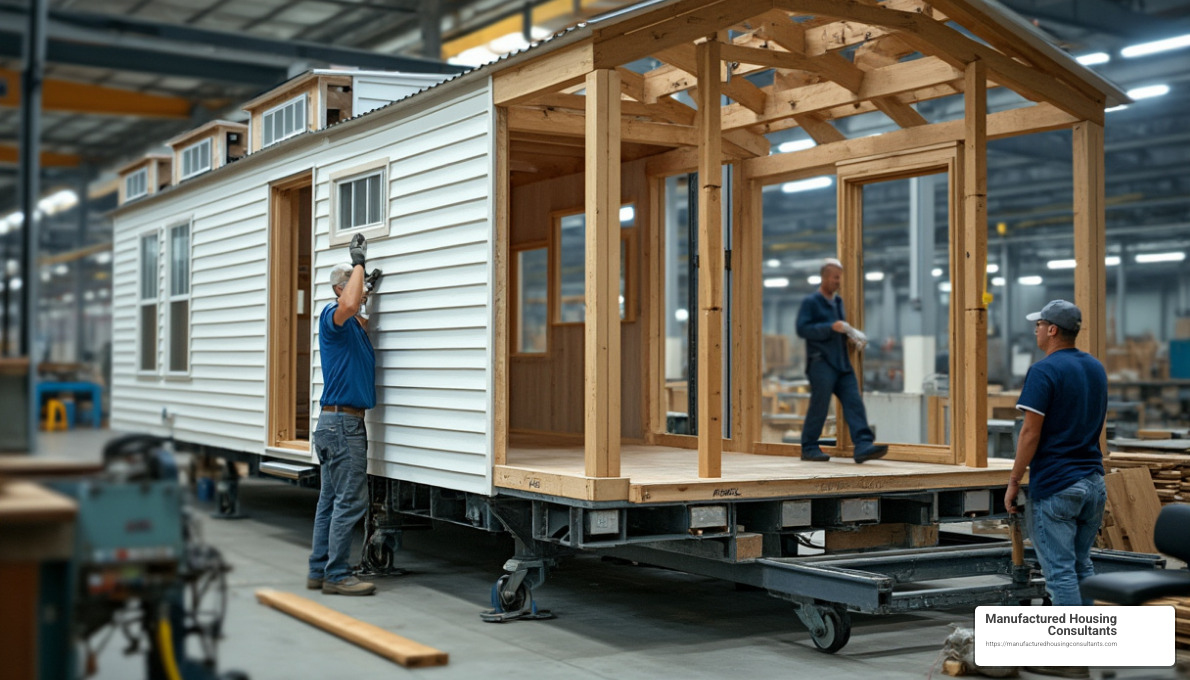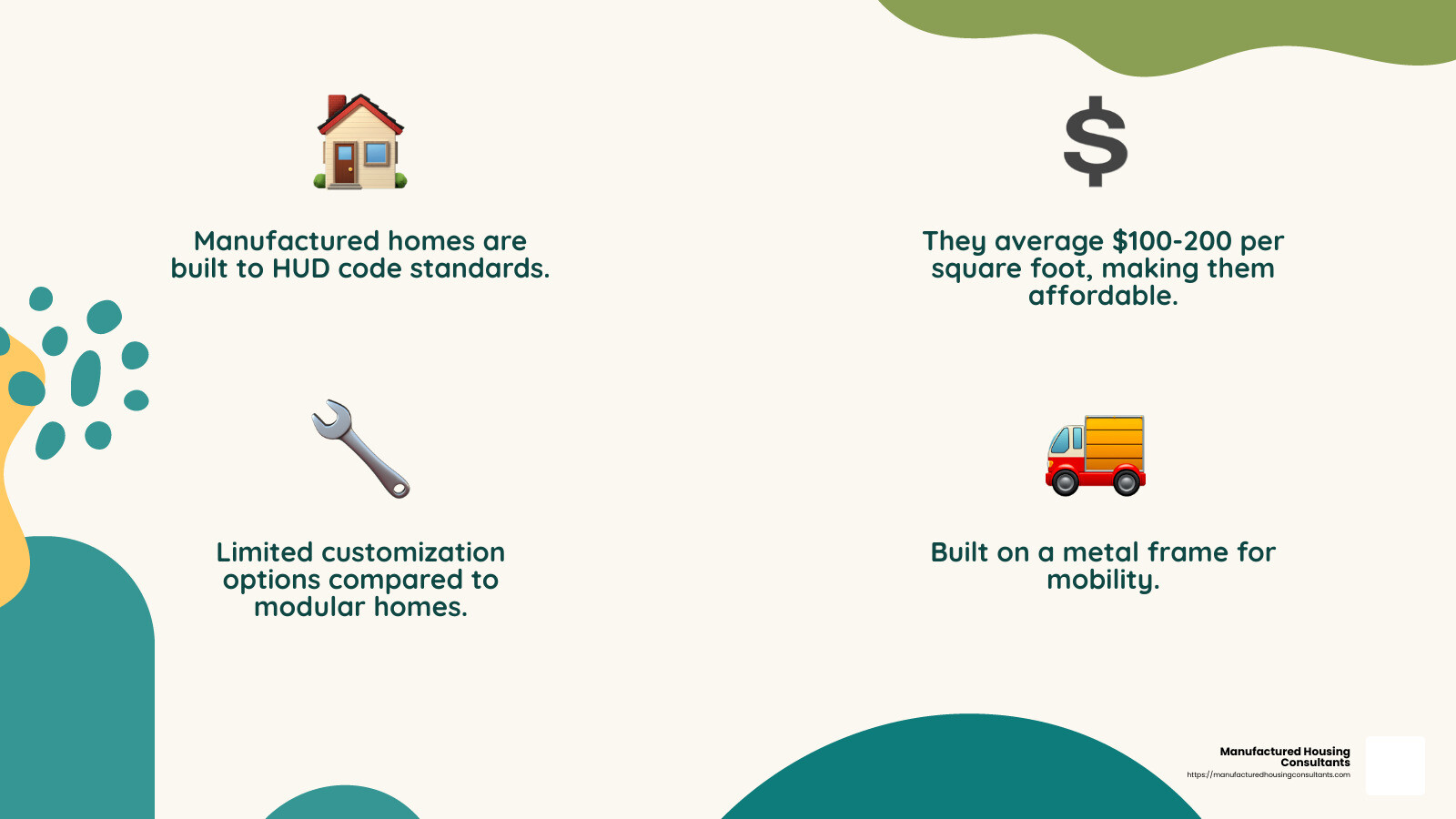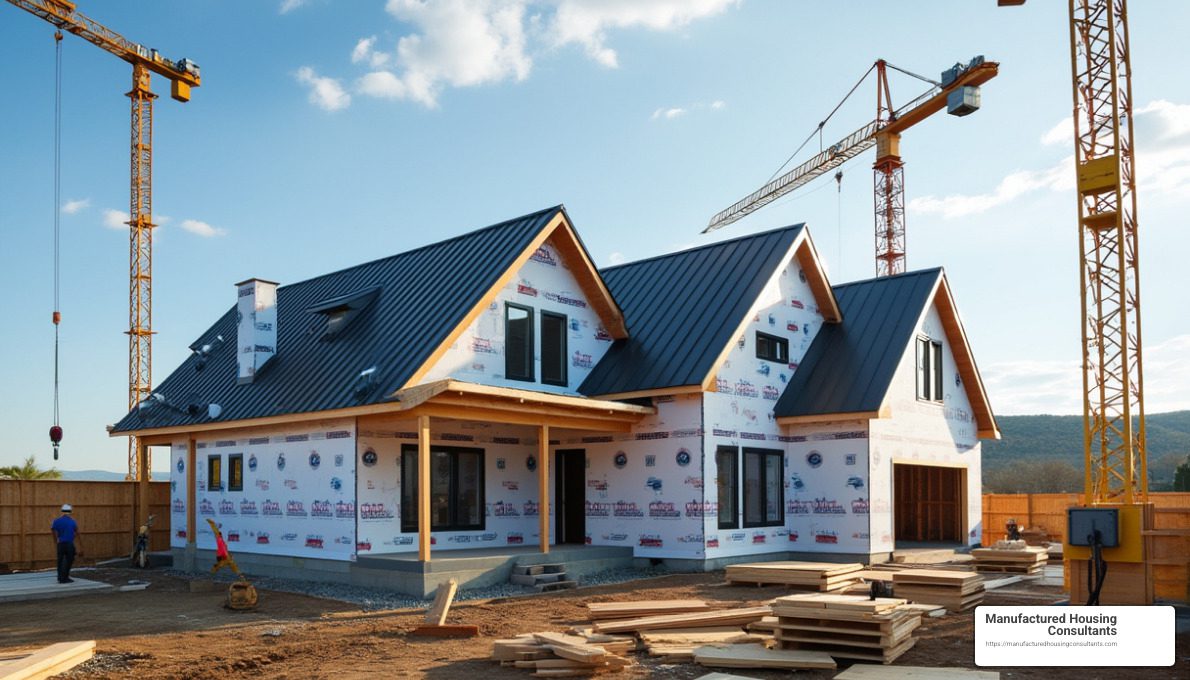Modular vs manufactured home: This phrase might initially bring confusion to many who are considering affordable and customizable housing solutions. However, understanding the core differences will guide your decision in choosing the right path for your new home journey.
- Modular homes are constructed in factory settings and assembled on-site, adhering to the same local building codes as traditional homes. They offer extensive customization and are often seen as more permanent housing options.
- Manufactured homes, on the other hand, are built under federal HUD Code, ensuring affordability and efficiency but with potential limitations in design customization.
In off-site built homes, both modular and manufactured houses share common traits of being prefabricated units, crafted in controlled environments before reaching their final destinations. This process not only ensures uniform quality and speedier construction compared to traditional methods but also aligns well with budget-conscious buyers in Texas.
For those on a quest for affordable homeownership, understanding the distinctions between these prefabricated options is crucial. Modular homes are assembled on permanent foundations and offer design flexibility, while manufactured homes come with built-in mobility features and cost-effectiveness. Both promising pathways to achieving the dream of homeownership.

Understanding Modular Homes
Construction Process
Modular homes are built in a controlled environment inside a factory. This ensures every piece is crafted with precision and meets strict quality standards. Think of it like building a giant puzzle, where each piece is carefully created to fit perfectly when assembled on-site.
Unlike traditional homes, modular homes are assembled much faster. The factory setting means weather delays are a thing of the past. Plus, the process is more efficient, reducing waste and saving on costs.
Once the pieces are ready, they are transported to the home site and put together. The final assembly must comply with state and local building codes. This is crucial because it means modular homes are held to the same safety and quality standards as any other house in your neighborhood.
A key feature of modular homes is their permanent foundation. Once assembled, they are fixed to the land, making them a stable and lasting housing option.
Customization and Design
One of the biggest perks of choosing a modular home is its design flexibility. Buyers can enjoy a wide range of customization options. Whether it’s a cozy single-family residence or a spacious two-story colonial, there’s a modular design to fit every lifestyle.
Modular homes can be custom to your taste. From the layout to the type of flooring, you can work closely with builders to create your dream home. Imagine choosing everything from the color of your walls to the style of your kitchen cabinets.
This flexibility extends beyond aesthetics. Modular homes can be designed to include energy-efficient features. This not only helps the environment but also cuts down on utility bills.
In summary, modular homes offer a blend of customization and quality control that makes them an attractive choice for those seeking a home that suits their unique needs. They provide the stability of a traditional home with the added benefits of modern, efficient construction methods.
Understanding Manufactured Homes
Manufactured homes, often referred to as mobile homes, are built in factories and adhere to a specific set of federal guidelines known as the HUD code. This code ensures that these homes meet standards for safety, durability, and energy efficiency. Unlike modular homes, manufactured homes are built on a metal frame with steel beams, giving them a distinct mobility feature.
Construction Process
The construction of manufactured homes begins in a factory, where each unit is assembled on a chassis. This steel frame provides the support needed to transport the home to its designated site. The process is streamlined and efficient, much like an assembly line, which helps keep costs down.

Once completed, these homes are transported to their location, often on their own wheels. This makes them different from modular homes, which are transported in sections and assembled on-site. The pier and beam foundation commonly used for manufactured homes allows for easy setup and potential relocation if needed.
Features and Limitations
Manufactured homes are known for their affordability. They typically cost less than traditional site-built homes, making them an attractive option for those on a budget. According to the Manufactured Housing Institute, they are priced at around $100-200 per square foot, which is significantly lower than the cost of a new traditional home.
However, the downside is their limited customization. While there are various floor plans and styles available, buyers have fewer options to personalize their home compared to modular homes. This can make it harder to update or expand the home in the future.

Additionally, manufactured homes are often placed on leased land, which can complicate financing. They are generally considered personal property rather than real property, affecting loan options and insurance. Despite these limitations, manufactured homes offer a practical solution for affordable housing, especially in areas with high real estate prices.
In summary, manufactured homes provide a cost-effective and mobile housing option. They are ideal for those seeking affordability and flexibility, but they come with trade-offs in terms of customization and financing.
Modular vs Manufactured Home: Key Differences
When you’re deciding between a modular vs manufactured home, it’s important to understand the key differences. These differences can impact everything from building codes to financing options. Let’s explore the details.
Cost Comparison
Price Range: Modular homes often come with a higher price tag compared to manufactured homes. Modular homes are typically priced between $150 to $400 per square foot, while manufactured homes range from $100 to $200 per square foot. This price difference is due to the construction standards and customization options available with modular homes.
Prefab Cost vs. Custom Cost: Modular homes, being more customizable, can lead to higher costs if you opt for unique designs or upscale materials. Manufactured homes, on the other hand, offer a more standardized design, which keeps costs lower.

Frequently Asked Questions about Modular vs Manufactured Homes
What is the difference between a modular and a manufactured home?
When comparing a modular vs manufactured home, the primary difference lies in the building codes and foundation types. Modular homes are constructed to meet local and state building codes, similar to traditional homes. They are placed on permanent foundations, which could be a slab, crawl space, or basement. This allows them to be classified as real property, similar to site-built homes.
Manufactured homes, however, adhere to the HUD code, a national standard set by the Department of Housing and Urban Development. These homes are built on a steel chassis and often rest on a pier and beam foundation, which provides mobility. As a result, they are typically classified as personal property unless permanently affixed to land.
What are the negatives of modular homes?
While modular homes offer numerous benefits, there are a few drawbacks to consider:
- Cost: Modular homes can be more expensive than manufactured homes, with prices ranging from $150 to $400 per square foot. The cost can increase further if you choose custom designs or high-end materials.
- Land Restrictions: Not all areas permit modular homes. It’s crucial to check local zoning laws and HOA restrictions before purchasing land for a modular home.
- Loan Process: Financing a modular home can be similar to a traditional home, but it requires a standard mortgage. This can be a lengthy process and might require more stringent qualifications compared to loans for manufactured homes.
How much does a 3,000 sq ft modular home cost?
The cost of a 3,000 square foot modular home can vary significantly based on customization and materials used. Generally, the price range for modular homes is between $150 to $400 per square foot. This means a 3,000 sq ft modular home could cost anywhere from $450,000 to $1,200,000.
Prefab Cost vs. Custom Cost: The base price for a modular home includes the prefab cost, which covers standard designs and materials. If you opt for custom features or upscale finishes, expect the costs to rise. Custom costs can include everything from unique floor plans to premium appliances and fixtures.
Understanding these factors can help you make an informed decision about whether a modular or manufactured home is right for you.
Conclusion
At Manufactured Housing Consultants, we believe that everyone deserves access to affordable housing. Whether you’re considering a modular or manufactured home, we offer solutions that fit a variety of needs and budgets. Our expertise in the industry ensures that you receive the best guidance throughout your home-buying journey.
Why Choose Us?
- Affordable Options: We specialize in providing cost-effective housing solutions. Our homes are designed to offer quality and affordability without compromising on style or comfort.
- Texas Delivery: With locations across Texas, including San Antonio, Von Ormy, and Corpus Christi, we guarantee delivery anywhere in the state. This allows us to bring your dream home directly to you, no matter where you are.
- Comprehensive Services: From financing to customization, we cover all aspects of the buying process. Our team is here to assist you with everything, ensuring a seamless experience from start to finish.
Choosing between a modular vs manufactured home can be a big decision. Each has its own set of advantages and considerations. But with our help, you can find the perfect fit for your lifestyle and budget. Explore our modular homes to learn more about how we can make your homeownership dreams a reality.
Whether you’re looking for a home that meets local building codes or one that’s HUD-approved, we’re here to help you every step of the way. Accept the opportunity to own a home that suits your needs and enjoy the benefits of affordable, quality living in Texas.





